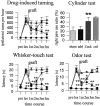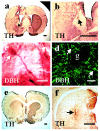Functional regeneration in a rat Parkinson's model after intrastriatal grafts of glial cell line-derived neurotrophic factor and transforming growth factor beta1-expressing extra-adrenal chromaffin cells of the Zuckerkandl's organ
- PMID: 11739596
- PMCID: PMC6763029
- DOI: 10.1523/JNEUROSCI.21-24-09888.2001
Functional regeneration in a rat Parkinson's model after intrastriatal grafts of glial cell line-derived neurotrophic factor and transforming growth factor beta1-expressing extra-adrenal chromaffin cells of the Zuckerkandl's organ
Abstract
Intrabrain transplantation of chromaffin cell aggregates of the Zuckerkandl's organ, an extra-adrenal paraganglion that has never been tested for antiparkinsonian treatment, induced gradual improvement of functional deficits in parkinsonian rats. These beneficial effects were related to long survival of grafted cells, striatal reinnervation, and enhancement of dopamine levels in grafted striatum. Grafted cells were not dopaminergics, but they expressed glial cell line-derived neurotrophic factor (GDNF) and transforming growth factor-beta(1). These factors were detected in the host striatal tissue, indicating that chromaffin cells secreted them after grafting. Because glial cell line-derived neurotrophic factor possesses neurorestorative properties over dopaminergic neurons, and transforming growth factor-beta(1) is a cofactor that potentiates the neurotrophic actions of GDNF, functional regeneration was likely caused by the chronic trophic action of neurotrophic factors delivered by long-surviving grafted cells. This work should stimulate research on the clinical applicability of transplants of the Zuckerkandl's organ in Parkinson's disease.
Figures




Similar articles
-
Grafts of extra-adrenal chromaffin cells as aggregates show better survival rate and regenerative effects on parkinsonian rats than dispersed cell grafts.Neurobiol Dis. 2008 Mar;29(3):529-42. doi: 10.1016/j.nbd.2007.11.009. Epub 2007 Nov 28. Neurobiol Dis. 2008. PMID: 18206378
-
[Natural "dopaminotrophic" cell transplant: a new concept in antiparkinsonian therapy].Rev Neurol. 2003 Mar 16-31;36(6):540-4. Rev Neurol. 2003. PMID: 12652418 Review. Spanish.
-
Astrocyte delivery of glial cell line-derived neurotrophic factor in a mouse model of Parkinson's disease.Exp Neurol. 2002 Apr;174(2):230-42. doi: 10.1006/exnr.2002.7877. Exp Neurol. 2002. PMID: 11922664
-
Implantation of bioactive growth factor-secreting rods enhances fetal dopaminergic graft survival, outgrowth density, and functional recovery in a rat model of Parkinson's disease.Exp Neurol. 2000 Jul;164(1):130-8. doi: 10.1006/exnr.2000.7411. Exp Neurol. 2000. PMID: 10877923
-
Towards a neuroprotective gene therapy for Parkinson's disease: use of adenovirus, AAV and lentivirus vectors for gene transfer of GDNF to the nigrostriatal system in the rat Parkinson model.Brain Res. 2000 Dec 15;886(1-2):82-98. doi: 10.1016/s0006-8993(00)02915-2. Brain Res. 2000. PMID: 11119690 Review.
Cited by
-
Transcription factor Six2 mediates the protection of GDNF on 6-OHDA lesioned dopaminergic neurons by regulating Smurf1 expression.Cell Death Dis. 2016 May 5;7(5):e2217. doi: 10.1038/cddis.2016.120. Cell Death Dis. 2016. PMID: 27148690 Free PMC article.
-
Selective glial cell line-derived neurotrophic factor production in adult dopaminergic carotid body cells in situ and after intrastriatal transplantation.J Neurosci. 2005 Apr 20;25(16):4091-8. doi: 10.1523/JNEUROSCI.4312-04.2005. J Neurosci. 2005. PMID: 15843611 Free PMC article.
-
Cell loss and autophagy in the extra-adrenal chromaffin organ of Zuckerkandl are regulated by glucocorticoid signalling.J Neuroendocrinol. 2013 Jan;25(1):34-47. doi: 10.1111/j.1365-2826.2012.02367.x. J Neuroendocrinol. 2013. PMID: 23078542 Free PMC article.
-
Chromaffin progenitor cells from the adrenal medulla.Cell Mol Neurobiol. 2010 Nov;30(8):1417-23. doi: 10.1007/s10571-010-9571-3. Epub 2010 Nov 16. Cell Mol Neurobiol. 2010. PMID: 21080061 Free PMC article.
-
Let's make microglia great again in neurodegenerative disorders.J Neural Transm (Vienna). 2018 May;125(5):751-770. doi: 10.1007/s00702-017-1792-x. Epub 2017 Oct 12. J Neural Transm (Vienna). 2018. PMID: 29027011 Free PMC article. Review.
References
-
- Aebischer P, Ridet J-L. Recombinant proteins for neurodegenerative diseases: the delivery issue. Trends Neurosci. 2001;24:533–540. - PubMed
-
- Ahonen M, Soinila S, Joh TH. Pre- and postnatal development of rat retroperitoneal paraganglia. J Auton Nerv Syst. 1987;18:11–120. - PubMed
-
- Bankiewicz KS, Palmatie M, Plunkett RJ, Cummins A, Oldfield EH. Reversal of hemiparkinsonian syndrome in nonhuman primates by amnion implantation into caudate nucleus. J Neurosurg. 1994;81:869–876. - PubMed
-
- Batchelor PE, Liberatore GT, Wong JYF, Porritt MJ, Frerichs F, Donnan GA, Howells DW. Activated macrophages and microglia induce dopaminergic sprouting in the injured striatum and express brain-derived neurotrophic factor and glial cell line-derived neurotrophic factor. J Neurosci. 1999;19:1708–1716. - PMC - PubMed
-
- Beck KD, Valverde J, Alexi T, Poulsen K, Moffat B, Vandlen RA, Rosenthal A, Hefti F. Mesencephalic dopaminergic neurons protected by GDNF from axotomy-induced degeneration in the adult brain. Nature. 1995;373:339–341. - PubMed
Publication types
MeSH terms
Substances
LinkOut - more resources
Full Text Sources
